Commentary on John 20:19-31
The references to “Doubting Thomas” cast this story in a particular light. (While there was a period during which the story was referred to as “Inquisitive Thomas,” this has gone by the wayside.) It is noteworthy that only John gives this disciple much airtime. In the other gospels, Thomas appears only as a name on the list of disciples (Matthew 10:3, Mark 3:18, Luke 6:15). In John, however, Thomas appears not just in a list of disciples (John 21:2), but is featured in three stories.
Thomas first appears in the story of the raising of Lazarus (John 11, the Narrative Lectionary reading for the 1st Sunday of Lent this year). When Jesus proposes to return to Judea after hearing of Lazarus’ death, the other disciples counsel him not to go (verse 8). Why would he go back to the place where the Jews threatened to stone him (see John 10:31, 39)? Then they seek to dissuade Jesus by taking his reference to Lazarus “sleeping” literally. They argue that Lazarus will recover without Jesus’ help or presence (verse 12). But Thomas “said to his fellow disciples, ‘Let us also go, that we may die with him.’” (verse 16).
In John 14, Jesus says he is going to prepare a place for his followers. Thomas responds to this statement of Jesus. saying: “Lord, we do not know where you are going. How can we know the way?” (verse 5). Together these two statements reflect a disciple who is committed to following Jesus, first to death and then to places unknown. (Do you remember the declaration of Toy Story’s Buzz Lightyear “To infinity and beyond”? Thomas will follow Jesus wherever he goes—to death and beyond death to places unknown.)
The third story of Thomas in John begins with Thomas’ absence. This event occurs on the first Sunday after Easter, as it does in the Narrative Lectionary. The disciples are behind locked doors “for fear of the Jews.” But Thomas is not there. Somehow the moniker “Doubting” casts aspersions on Thomas for his absence, implying that he should’ve been there. Maybe he was depressed and melancholy and therefore avoidant.
But Thomas has already demonstrated (or remonstrated!) that he is not to be stopped by threats to his safety. Perhaps he is out and about seeking to follow Jesus, as he had volunteered to do, even unto death. Perhaps his absence means his moniker should be “Brave” or “Faithful” instead of “Doubting.”
Out looking to follow Jesus unto death, out where those who would harm him could find him, Thomas missed Jesus. When he hears that he has missed the unbelievable visit of Jesus in the flesh, he declares that he wants to see this miracle for himself. He says, “Unless I see the mark of the nails in his hands, and put my finger in the mark of the nails and my hand in his side, I will not believe” (verse 25b).
A week later, Thomas gets his chance. Jesus comes for another visit. And Jesus shows Thomas his stigmata. The Christ shares with Thomas his healing wounds. Note that the narrative does not say that Thomas actually puts his fingers in the nail marks in Jesus’ hands and puts his hand in Jesus’ side. Here interpretations divide, with Catholics generally taking the position that Thomas touched Jesus’ wounds, and Protestants generally arguing that Thomas seeing the wounds was enough.
In either case, Thomas gets his own, in-person revelation of the wounds of Christ. He gets his own, in-person revelation of Jesus’ resurrection. And he responds with his own, in-person revelation of who Jesus is: “My Lord and my God!” And Jesus accepts Thomas’ testimony.
Then Jesus says, “Blessed are those who have not seen and yet have come to believe” (verse 29b). And so, neither the traditionally Catholic emphasis on touching nor the traditionally Protestant emphasis on seeing are praised by Jesus. Instead, by praising those who believe without seeing, Jesus redirects us from an emphasis on touching or seeing to an emphasis on believing.
What are we to believe? Thomas’ belief that he could and would follow Jesus unto death is re-cast. His question of how to follow Jesus to where he is going is answered. Following Jesus leads not just to death, but beyond. Now it turns out that this beyond is beyond what could be asked or imagined. This beyond means the resurrection. Following Jesus leads not just to seeing him, but to knowing him for who he is. What we are to believe is “that Jesus is the Messiah, the Son of God.” And when we so believe, we will “have life in his name” (verse 31).
Such believing is not simply ascribing to a statement of belief or a confession of faith. This belief comes from knowing and experiencing the risen Christ. This belief doesn’t just change our understanding of death This belief changes our understanding of the great beyond. The resurrected Christ, present among us, changes our very lives. The resurrected Christ, who meets us where we are, changes our very selves. Thanks be to God.
PRAYER OF THE DAY
God of resurrection,
Your son, Jesus, awed his followers by appearing among them. With awe we also celebrate his resurrection and rejoice in eternal life. Amen.
HYMNS
Come down, O Love divine ELW 804, H82 516, UMH 475, NCH 289
We walk by faith ELW 635, H82 209
You satisfy the hungry heart ELW 484
CHORAL
The road to Damascus, Frederick Frahm


April 24, 2022